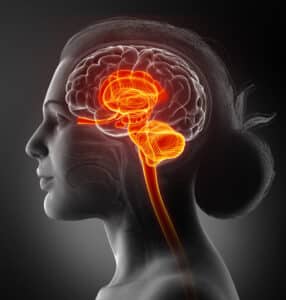What is Trigeminal Neuralgia?
Trigeminal neuralgia, also known as tic douloureux, is a type of nerve disorder. This chronic condition causes severe, shooting pain in the face. Some people with the condition only experience a fleeting, momentary twinge, while others suffer from frequent bouts of extreme pain.

Trigeminal neuralgia can affect one of several areas of the head and face. The trigeminal nerve is responsible for sensation all around the face including the eyes, mouth, and sinus cavities. The pain that is produced usually comes on suddenly and can last from a few seconds to a few minutes, but maybe physically and mentally incapacitating. Episodes can be triggered by certain activities that cause vibration or contact with the cheek, such as shaving, brushing your teeth, or applying makeup, as well as eating, drinking, or talking. As the condition progresses, the episodes of pain may become longer and more frequent.
Causes of Trigeminal Neuralgia
Trigeminal neuralgia is typically brought on by contact between a normal artery or vein and the trigeminal nerve. It may be the result of a blood vessel pressing on the trigeminal nerve as it exits the brain. The condition occurs most often in people over the age of 50 and tends to affect a larger percentage of women than men. Trigeminal neuralgia may be related to multiple sclerosis or other neurological conditions that damage the myelin sheath that protects nerves. Although less common, trigeminal neuralgia may be caused by a tumor on the trigeminal nerve as well.
What are the symptoms of Trigeminal Neuralgia?
The pain of trigeminal neuralgia usually follows one or more of these patterns:
- Episodes of severe, shooting, or jabbing pain that may feel like an electric shock
- Spontaneous attacks of pain or attacks triggered by simple things such as touching your face, chewing, speaking, or brushing your teeth
- Bouts of pain lasting for a few seconds to several minutes
- An episode of several attacks lasting days, weeks, months, or longer
- The constant aching, burning sensation that may precede it evolving into spasm-like pain
- Pain in areas supplied by the trigeminal nerve, including the cheek, jaw, teeth, gums, lips, and less often the eye and forehead
- Pain affecting one side of the face at a time, rarely affecting both sides
- Attacks that increase in frequency and intensity with time

Common Risk Factors for Developing Trigeminal Neuralgia
These are the common risk factors for this nerve condition:
- Sex — Women are more likely to develop trigeminal neuralgia than men.
- Age — The risk of developing this condition increases with age. It is higher in people who are between the ages of 50 and 60. This is due to the elongation and hardening of the blood vessels and brain sagging, which can create new contacts between nerves and blood vessels.
- Multiple sclerosis — Multiple sclerosis is a chronic disease that can affect the brain, spinal cord, and optic nerves. Because it also affects the protective myelin coating of the nerves, it can lead to trigeminal neuralgia.
How common in Trigeminal Neuralgia?
This is a rare condition affecting an estimated 15,000 Americans every year. As noted above, it is more common in women than men, and in people over the age of 50.
How we treat Trigeminal Neuralgia
The first course of treatment is typically to try medication options to see if they have success alleviating the patient’s pain. The goal of these medications is to lessen or block the pain signals being sent to the brain.

- Anticonvulsants — There are a variety of anticonvulsant drugs that can be effective for trigeminal neuralgia. The most commonly used is carbamazepine. Over time, the drug’s effectiveness can begin to deteriorate, and we can switch the patient to another drug. Side effects can be a problem: dizziness, confusion, drowsiness, and nausea. In some people, mainly those of Asian descent, a serious drug reaction can occur.
- Antispasmodic agents — Muscle relaxing drugs, such as baclofen, may be used alone or in combination with carbamazepine.
- Botox injections — Botox, well-known for its aesthetic use for wrinkle treatments, can also be effective for treating trigeminal neuralgia, as it can relax muscles pushing on the nerve. But this is a new usage and hasn’t been researched very much.
- Surgery — When medications are not reducing the patient’s pain, surgery to decompress the trigeminal nerve is the next course. There are various surgical options for decompressing the nerve.
- Balloon compression — A needle is inserted through the face to a part of the trigeminal nerve that goes through the base of the skull. Then we thread a thin, flexible catheter with a balloon on the end through the needle. The balloon is inflated with enough pressure to damage the trigeminal nerve, blocking the pain signals.
- Microvascular decompression — The goal of this procedure is to remove or relocate blood vessels that are in contact with the trigeminal nerve root. Our Texas Neurosurgery surgeons make an incision behind the ear on the side the patient is experiencing pain. A small hole is then made in the skull. Through this hole, we move any arteries that are in contact with the trigeminal nerve. We then place a soft cushion between the nerve and the arteries. If a vein is compressing the nerve, we may remove it. We may also cut part of the trigeminal nerve if arteries are not pressing on it. This procedure successfully eliminates pain or dramatically reduces pain in most people, but the pain can return in time in some.
- Brain stereotactic radiosurgery — In this procedure, we direct a focused dose of radiation to the root of the patient’s trigeminal nerve. The radiation damages the trigeminal nerve and reduces or eliminates the patient’s pain. Results are not immediate and may take up to a month. If the pain recurs, this procedure can be repeated.
- Glycerol injection — A needle is inserted through the face and into an opening in the base of the skull. The needle is moved into the trigeminal cistern, a small sac of spinal fluid that surrounds the trigeminal nerve ganglion (where the trigeminal nerve divides into three branches) and part of its root. A small amount of sterile glycerol is injected, and this damages the trigeminal nerve, which then blocks nerve pain signals.
- Radiofrequency thermal lesioning — The patient is sedated, and we insert a hollow needle through the face into the site where the trigeminal nerve goes through an opening at the base of the skull. Once the needle is in position, the patient is briefly roused from sedation. An electrode is run through the needle to the spot where it delivers a mild electrical current through the tip of the electrode. The patient is asked to indicate when and where he or she feels tingling. Once the part of the nerve causing the pain has been located the patient is returned to sleep sedation. The electrode is heated until it damages the nerve fibers, creating a lesion on the nerve. If the pain hasn’t been fully alleviated, additional lesions may be created. When this option is used, pain may return in three to four years.
Patient Testimonial
“Was able to see Dr Mayer very quickly. He is very kind and responsive. He explained options, had great bedside manner and was able to do surgery quickly. The surgery went very well and I was able to have pain relief almost immediately. I’d highly recommend Dr Mayer to anyone searching for a spine surgeon.”
Trigeminal Neuralgia FAQs:
What Can Trigger Trigeminal Neuralgia?
If you are living with Trigeminal Neuralgia, you may find that some foods trigger your attacks, such as bananas, fruits that are citrusy, and caffeine. You may also notice that certain activities cause the condition to flare up, such as brushing your teeth, talking, chewing, smiling, or shaving.
Who is a Good Candidate for Trigeminal Neuralgia Surgery?
To be considered a potential candidate for Trigeminal Neuralgia surgery, you will need to undergo an MRI to make sure you don’t have any other causes for your symptoms and be properly diagnosed with Trigeminal Neuralgia. You must also be considered an overall healthy person.
Should I Drive if I Have Trigeminal Neuralgia
Because Trigeminal Neuralgia causes such pain in your face, it is not recommended that you operate a vehicle.
What is a Common Misdiagnosis For Trigeminal Neuralgia?
Trigeminal Neuralgia is known to be mistaken for acute migraines, cluster headaches, and postherpetic neuralgia.
What happens if Trigeminal Neuralgia is left untreated?
There is no cure for trigeminal neuralgia. This nerve condition typically worsens with time. So, although the patient is likely already feeling severe pain, it will only get worse or become more frequent if left untreated. There’s no reason to live with the pain. At Texas Neurosurgery, we can help reduce or fully alleviate your pain from trigeminal neuralgia.
Schedule Your Consultation in Dallas, TX Today
If you’re interested in learning more about trigeminal neuralgia treatment please contact us for a consultation with one of our providers at 214-823-2052 or fill out our contact us form. We will discuss your needs and concerns, and determine your best course of action.

